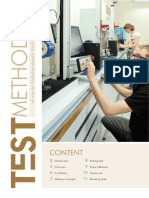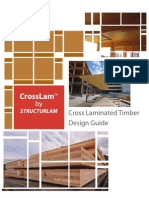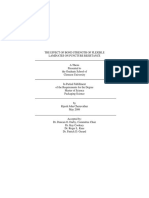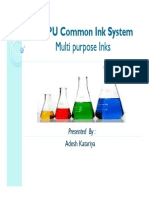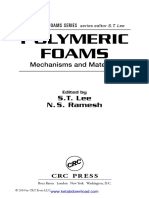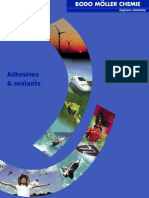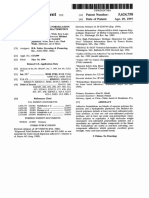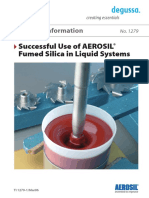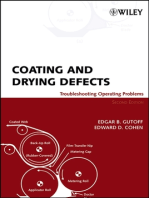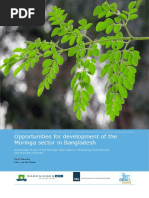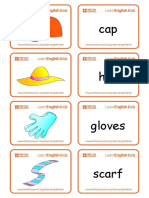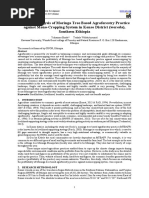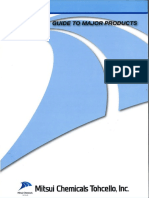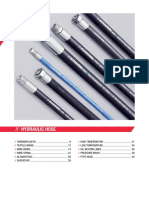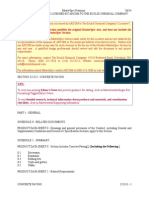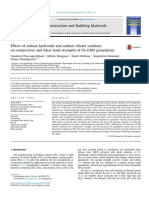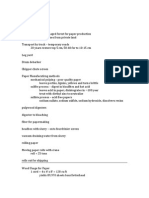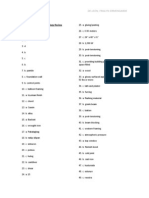0 ratings0% found this document useful (0 votes)
468 viewsWater Based Adhesives
Water Based Adhesives
Uploaded by
Abhineet Shrivastavawater based adhesive
Copyright:
Attribution Non-Commercial (BY-NC)
Available Formats
Download as PDF, TXT or read online from Scribd
Water Based Adhesives
Water Based Adhesives
Uploaded by
Abhineet Shrivastava0 ratings0% found this document useful (0 votes)
468 views0 pageswater based adhesive
Copyright
© Attribution Non-Commercial (BY-NC)
Available Formats
PDF, TXT or read online from Scribd
Share this document
Did you find this document useful?
Is this content inappropriate?
water based adhesive
Copyright:
Attribution Non-Commercial (BY-NC)
Available Formats
Download as PDF, TXT or read online from Scribd
Download as pdf or txt
0 ratings0% found this document useful (0 votes)
468 views0 pagesWater Based Adhesives
Water Based Adhesives
Uploaded by
Abhineet Shrivastavawater based adhesive
Copyright:
Attribution Non-Commercial (BY-NC)
Available Formats
Download as PDF, TXT or read online from Scribd
Download as pdf or txt
You are on page 1of 0
1
n light of ever-tightening governmental and
environmental legislation to reduce volatile
organic compound (VOC) emissions, the exi-
ble lm and paper laminating industry is rapid-
ly changing from solvent-based adhesives to
new water-based polyurethane adhesives and
acrylic emulsions for dry-bond laminating. In
addition, very low residual monomer 100 per-
cent solids systems are rapidly gaining accep-
tance as an alternative technology to tradition-
al dry-bond laminating techniques.
Dry-bond laminating is the process of coating either a
solvent-based or water-based adhesive to a substrate,
drying the adhesive with heat and airow and then lami-
nating the adhesive to a second substrate via a heated
compressi on ni p that mates the fi l ms together.
Solventless laminating, on the other hand, involves
metering a low-viscosity adhesive onto a multiple-appli-
cation roll conguration that applies the adhesive to the
rst substrate, which is then mated to a second substrate
using a heated nip. Whether the laminating technique is
dry-bond or solventless, adhesive coating weights are
typically 1.0 1. 5 lbs. per 3,000 ft., requiring a relatively
small adhesive coating weight to meet the nished lami-
nate performance requirements.
A typical laminating converters product line is com-
posed of structures using polyolenic lms such as poly-
ethylene terephthalate, polypropylene and polyethylene I
WATE R- B AS E D
ADHESIVES
SOLVENTLESS LAMINATION REDUCES
FLEXIBLE PACKAGING VOCS
I By Peter A. Voss
Editors Note: The following article is based on a presentation given by
Peter A. Voss, Global Program Manager-Flexible Packaging, H.B. Fuller Co.,
at a Flexo on Unsupported Film seminar in Spring 2001. The seminar was
sponsored by Akzo Nobel Inks at the companys Center for Technical
Excellence in Plymouth, MN. For more information on Akzo Nobel Inks sem-
inars, contact Emily Horn at (800) 328-7838, ext. 326.
HOT TECHNOLOGIES I
Laminator
Lamination
Unwind
Print and
Lamination
Rewind
Stock
Unwind
Central Impression
Press
Adhesive
Applicator
This six-color central-impression press has been modified for laminating after printing.
2
as well as paper and aluminum foil. The nished lamina-
tions can be used for a variety of end-use applications,
although food packaging consumes the largest portion of
these laminations.
Whi l e t here are many appl i cat i ons for f l exi bl e
packaging laminates, there are relatively few key perfor-
mance requirements that they all share. The adhesives
must have excellent clarity and bond strengths as well
as be resistant to extremes of heat and humidity. In
addition, the adhesive must be resistant to tunneling.
Tunneling is the localized separating or delamination of
the two substrates being bonded together. Tunneling
often occurs when the two films differ in extensibility,
and stretch or relax at different rates. These localized
delaminations can have a detrimental effect on package
appearance and a potentially damaging effect on the
package contents, and remains the major concern for
most converters.
Water-Based Adhesives
The flexible packaging adhesive market is estimated
at $130 million, of which approximately only 25 percent is
supplied by either acrylic emulsions or polyurethane dis-
persions (PUDs). Aside from governmental pressure for
laminating converters to switch from solvent-based prod-
ucts to waterborne, there has been little incentive for
these converters to make a change. The introduction of
improved crosslinkers (catalysts to increase the perfor-
mance of the adhesive) such as dispersible iso-
cyanates, polyfunctional aziridines and polyfunctional
carbodiimides enables the water-based adhesives to
meet many of the performance criteria when the lamina-
tion is subject to extremes of heat and humidity and is
narrowing the performance gap between solvent-based
and water-based adhesives.
Polyurethane Dispersions. In comparison to conven-
tional solvent-based polyurethanes, PUDs are the closest
performing water-based polymers in terms of adhesion
and resistance properties that are commercially avail-
able. PUDs typically have very low solution particle sizes
(<75nm). The particle size of a water-based adhesive
directly relates to the machinability (how well the product
runs on the equipment) of the adhesive on laminating
equipment and the ability to operate at maximum line
speeds. In addition, the low particle size enhances the
dried adhesives clarity to a level comparable to solvent-
based products. The main drawback to PUDs is cost.
PUDs are based on aliphatic diisocyanates such as
isophorone diisocyanate and tetramethylxylene diiso-
cyanate, which are significantly more expensive than
toluene diisocyanate, which is used in most solvent-
based polyurethanes.
Acrylic Emulsions. Acrylic emulsions offer the lami-
nating converter a low-cost product with moderate perfor-
mance properties, which often meets their requirements
for less stringent applications. In some cases, acrylics do
not meet converter requirements, in that the adhesion
and resistance properties are less than those of PUDs
and conventional solvent-based products. In addition,
acrylic polymers historically used in dry-bond laminating
had very poor machinability and required chilling the roll
to prevent the adhesive from coagulating.
These acrylics also suffered from a tendency to foam,
which, in combination with the machining issues, severely
limited the speed at which a converter could run the lami-
nator. Thus, much of the price advantage gained by using
a low-cost acrylic was erased by the decreased efficiency
of the laminating equipment.
New commercially available acrylic polymers are avail-
able with excellent machining properties that can be used
I HOT TECHNOLOGIES
Laminator
Lamination
Unwind
Rewind Print
Unwind
Central Impression
Press
Adhesive
Applicator
This in-line laminating setup incorporates a separate and self-contained laminating machine in-line with the flexo press.
3
at maximum dry-bond laminator line speeds of 700-800
fpm. In addition, when it is crosslinked with either a poly-
functional aziridine or dispersible isocyanate, the adhe-
sive system meets many of the heat and humidity resis-
tance properties that only a PUD could achieve.
Crosslinking Chemistry.
Crosslinking a water-based adhesive imparts a lamina-
tion with the necessary resistance properties to maintain
the package integrity when hot-lled, boiled or stored in a
refrigerated case. In addition, crosslinking the adhesive
significantly increases bond strengths and reduces the
possibility of tunneling.
There are several commercially available crosslinkers for
water-based polymers, each differing in reactivity, pot life (the
length of time the adhesive can be used after a crosslinker is
added) and effect on nal properties. It should be noted that
the adhesive polymers used with these crosslinkers are anion-
ic (stable in water), having carboxylic functionality in the back-
bone (reacts with the crosslinker), which is neutralized with a
volatile tertiary amine or ammonia. The presence of the car-
boxylate salt renders the polymer dispersible or emulsiable in
water.
Pot life is always a consideration with any two-compo-
nent ambient cure system. Reactions that occur through
the carboxylic acid functionality tend to have an excellent
pot life of eight to 10 hours because these reactions are
typically alkali-hindered. Polymers neutralized with ammo-
nia or an amine routinely have a pH >7.5. As the ammonia
or tertiary amine volatilizes during the drying process, the
carboxylic acid functionality becomes available to react with
the crosslinker. The isocyanate-hydroxyl reaction is com-
mon for solvent-based adhesive systems, resulting in
exceptional properties. When dispersible isocyanate
crosslinkers are used with water-based polymers, the sys-
tems are plagued by the isocyanate-water side reaction. As
a result of this reaction, dispersible isocyanate systems are
limited to pot lives of four to six hours in order to maintain
performance properties.
Although the water-based adhesives are dried at ele-
vated temperatures of up to 200 degrees F., due to short
dwell times of two to four seconds in the drying ovens it is
believed that the majority of the crosslinking reaction
takes place in the nished lamination at ambient temper-
atures, which are usually 77 degrees F. Heat-aging a dry-
bond lamination is not always required. In most cases, a
lamination can be cut or slit to its nal size almost imme-
diately after laminating. Even though the crosslinkers
have not fully reacted with the base polymer, there is still
enough laminate integrity for the slitting operation. This in
turn enables a laminator to produce material on a just-in-
time basis. Aside from the actual equipment used in pro-
duction, the rapid turnaround time of dry-bond laminating
is the most critical difference between dry-bond laminating
and solventless laminating.
Solventless Adhesives
First-Generation Adhesives. The first solventless
laminating adhesives developed were polyurethane mois-
ture-curing products. These adhesives are made from
isocyanate prepolymers, the reaction product of a polyol
with excess isocyanate. The prepolymers are high in vis-
cosity, which gives excellent initial bond strengths; how-
ever, they require an application temperature of 90 to 100
degrees C. The adhesive is coated onto the primary lm
and atmospheric moisture reacts with the excess iso-
cyanate groups to crosslink the adhesive after the sec-
ondary lm has been mated to the primary lm; slitting
can usually take place in 24 to 72 hours.
First-generation curing mechanism:
R-NCO + H2O _ R-NH2 + CO2
R-NH2 + R-NCO _ R-NHCOHN-R
The problems encountered with using these rst-gen-
eration adhesives are bubbles in the lamination, a cloudy
appearance in clear lms and inconsistency of the cure
rate. The bubbles are produced by the by-product carbon
dioxide of the curing reaction, and can be trapped when
high-barrier films are laminated. The amount of atmos-
pheric moisture that comes in contact with the adhesive
as it is coated can lead to a cloudy appearance in clear
films and an inconsistency in the cure rate. Moisture is
often added to the primary film by means of a spray
boom just prior to nipping the secondary film. This will
increase the rate of cure, but it also reduces the clarity of
the laminated lm by leaving a cloudy appearance. This
cloudy appearance can readily be seen in clear laminations
and in clear package window areas of printed structures.
Second-Generati on Adhesi ves. The next maj or
advancement in solventless laminating adhesives was
the development of two-part polyurethane adhesives.
These products are comprised of a polyurethane prepoly-
mer and a polyol, both low in viscosity. The components
are mixed together with a meter-mix-dispensing unit at
room temperature and pumped onto the coating station
of the laminator through an in-line static mixer. The
meter-mix in combination with the static mixer ensures
that the proper ratio of adhesive components is present
and completely mixed, resulting in a consistent cure rate.
Second-generation curing mechanism:
R-NCO + HO-R _ R-NHCOO-R
The problems encountered with using these second-
generation adhesives are low initial bond strengths and the
presence of high residual monomer. The low initial bonds
are a result of the low viscosity of both adhesive compo-
nents, which means tighter laminator controls are needed
to prevent laminations from tunneling before the adhesive
has a chance to properly cure. Slitting the lamination can
only take place after a 12- to 48-hour cure time. The high
residual isocyanate monomer causes a phenomenon
known as anti-seal. This occurs when the isocyanate
4
I HOT TECHNOLOGIES
monomer migrates through a soft sealant lm such as poly-
ethylene and reacts with atmospheric moisture. This reac-
tion creates a very hard and thermally stable polyurea layer
that renders the laminate unsealable. In addition to the anti-
seal problems, there are possible health risks due to worker
exposure from the high-residual monomer. Finally, the pres-
ence of isocyanate monomer requires EPA documentation
and reporting, which can be a time-consuming burden for
any laminating converter.
To address the problems associated with using rst- or
second-generation solventless adhesives, third-genera-
tion two-part polyurethane adhesive systems that have a
consi stent cure rate, l ow resi dual monomer and
increased initial bond strengths have been developed.
Third-Generation Adhesives. Typical third-generation
adhesives are based on moderate-viscosity polyurethane
polymers that require a 50-degree C. to 70-degree C.
application temperature. The increased viscosity of the
third-generation versus second requires a 12- to 24-hour
cure time before slitting. The third-generation adhesives
are made from a process that removes nearly all of the
excess isocyanate monomer from the prepolymer compo-
nent, consistently resulting in a blended adhesive system
with less than 0.08 percent free isocyanate. The low
residual isocyanate monomer eliminates the anti-seal
issue, health concerns from worker exposure to iso-
cyanate monomers and the regulatory documentation
associated with isocyanates.
Third-generation curing mechanism:
R-NCO + HO-R _ R-NHCOO-R
The majority of solventless laminators in the United
States are still applying a second-generation adhesive
system. The meter mix dispensing units are not generally
equipped with heating capabilities. In order for a laminat-
ing converter to begin using a third-generation adhesive,
a capital expenditure to update their meter-mix-dispens-
ing unit with heating capabilities is necessary. This capital
expenditure can often delay the conversion to a third-gen-
eration adhesive or altogether discourage a converter
from changing to a third-generation system.
To overcome this hurdle and keep the equipment
expenses associated with using a third-generation adhe-
sive system minimal, a third-generation adhesive has
been developed that can be pumped and mixed at room
temperature through existing meter-mix dispensing units
used with second-generation products. This system gives
a laminating converter the many benets of using a third-
generation adhesive without any expensive meter-mix
dispensing equipment upgrades.
Conclusion
As the government regulations to reduce VOC emis-
sions become more and more stringent, film-laminating
converters are faced with several choices that enable
them to comply with the new laws. Polyurethane disper-
sions and acrylic emulsions are very viable alternatives
to conventional solvent-based products; when they are
reacted with crosslinkers such as polyfunctional aziri-
dine or dispersible isocyanate, they have properties that
often exceed the solvent-borne systems. In addition,
third-generation solventless adhesives are an alterna-
tive technology to dry-bond laminating that also enables
a converter to meet the rapidly changing environmental
and performance standards.
About the Author
Peter A. Voss is industry technical manager, Flexible Packaging Group, for H.B.
Fuller Co., Vadnais Heights, MN. For more information about the new water-
based adhesives, call H.B. Fuller Co. at 651-236-5629.
Laminator
Lamination
Unwind
Laminated
Rewind
Printed
Unwind
Unwind
Rewind
Central Impression
Press
Adhesive Applicator
A flexo press with a separate laminator allows the converter to use both machines in tandem or independently, thus offering a wide variety of applications.
Copyright Foundation of Flexographic Technical Association FLEXO Magazine
FEBRUARY 2002
You might also like
- Adhesive Technology & Formulations (Technology Book)Document18 pagesAdhesive Technology & Formulations (Technology Book)Vijay Gupta46% (13)
- Film Coating Portfolio Polyester and BOPP FilmDocument69 pagesFilm Coating Portfolio Polyester and BOPP Filmkhalidkhanani100% (2)
- Irving Skeist, Jerry Miron (Auth.), Irving Skeist Ph.D. (Eds.) - Handbook of Adhesives-Springer US (1990)Document784 pagesIrving Skeist, Jerry Miron (Auth.), Irving Skeist Ph.D. (Eds.) - Handbook of Adhesives-Springer US (1990)Dung Nguyen100% (1)
- Epoxy Resins - Manufacturing Process of Epoxy ResinsDocument1 pageEpoxy Resins - Manufacturing Process of Epoxy ResinsChirag Thakur0% (1)
- 04 Laminating-Adhesives Glasbrenner PDFDocument28 pages04 Laminating-Adhesives Glasbrenner PDFAlmoosawiNo ratings yet
- Waxes For Engineering PlasticsDocument66 pagesWaxes For Engineering PlasticsOsov Gutim100% (1)
- Kuraray PVB Brochure 2013Document44 pagesKuraray PVB Brochure 2013sidneidecarvalhoNo ratings yet
- Polyurethane Adhesives and Sealants Based On Hydrophobic PolyolsDocument11 pagesPolyurethane Adhesives and Sealants Based On Hydrophobic PolyolsEhsan KhayalNo ratings yet
- Heat Seal Lacquers - How To Meet Today S and Tomorrow S Demands Od The Market 10.12.11. 04 PDFDocument17 pagesHeat Seal Lacquers - How To Meet Today S and Tomorrow S Demands Od The Market 10.12.11. 04 PDFamitNo ratings yet
- Hand Book of Adhesives With Their Formulates PDFDocument11 pagesHand Book of Adhesives With Their Formulates PDFRavi Prakash0% (2)
- Content: Conditions Adhesion Strength Rolling Ball Shear Adhesion Carton Test Breaking LoadDocument12 pagesContent: Conditions Adhesion Strength Rolling Ball Shear Adhesion Carton Test Breaking LoadJayant Kumar JhaNo ratings yet
- BoPET Applications 2016Document32 pagesBoPET Applications 2016SHRIPAD AMATENo ratings yet
- Pressure-Sensitive Adhesives and ApplicationsDocument761 pagesPressure-Sensitive Adhesives and ApplicationsPereaLuisina100% (6)
- Cost Comparison ExteriorDocument3 pagesCost Comparison ExteriorErwin Tan100% (2)
- Checklist For RCC WorkDocument4 pagesChecklist For RCC Workशंकर थापा100% (1)
- Chapter 1 - Sand CastingDocument22 pagesChapter 1 - Sand Castingdizainer_cy67% (3)
- Cross Laminated Timber Design GuideDocument10 pagesCross Laminated Timber Design Guidejcc19100% (2)
- Good Adhesive KnowledgeDocument129 pagesGood Adhesive KnowledgeHOANGVUNL19880% (1)
- Pressure Sensitive AdhesivesDocument22 pagesPressure Sensitive Adhesivesyemresimsek100% (2)
- Adhesive TapeDocument2 pagesAdhesive Tapeglh00No ratings yet
- Silicones and Structural AdhesivesDocument12 pagesSilicones and Structural AdhesivesDries Seuntjens100% (1)
- Flexible LaminatesDocument13 pagesFlexible LaminatesHimanshu GuptaNo ratings yet
- NC-PU Common Inks SystemDocument24 pagesNC-PU Common Inks SystemAdesh Gurjar71% (7)
- Polymeric Foams: Mechanisms and MaterialsDocument318 pagesPolymeric Foams: Mechanisms and MaterialsMarco HipolitoNo ratings yet
- Easaqua TolonateDocument11 pagesEasaqua TolonateAlptekinNo ratings yet
- New Stabilizer Solutions For Polyolefin Film GradesDocument52 pagesNew Stabilizer Solutions For Polyolefin Film GradesZirve Polimer100% (1)
- Eastman Benzoate ArticleDocument13 pagesEastman Benzoate Articlezlightyear100% (1)
- AdhesivesDocument12 pagesAdhesivesOmair Ali KhanNo ratings yet
- Barrier FilmsDocument37 pagesBarrier FilmsJulio GarcíaNo ratings yet
- Huntsman TPU IntruductionDocument26 pagesHuntsman TPU Intruductionjuliushasan2No ratings yet
- Barrier Films: Product CategoriesDocument3 pagesBarrier Films: Product CategoriesSh Mati ElahiNo ratings yet
- M Le Bras, C Wilkie, S Bourbigot-Fire Retardancy of Polymers New Applications of Mineral Fillers-Royal Society of Chemistry (2005)Document433 pagesM Le Bras, C Wilkie, S Bourbigot-Fire Retardancy of Polymers New Applications of Mineral Fillers-Royal Society of Chemistry (2005)Michaux Gwénaëlle100% (3)
- Water-Based Adhesive FormulationDocument6 pagesWater-Based Adhesive FormulationuripssNo ratings yet
- PU 2003 Trouble Shooting PUDocument35 pagesPU 2003 Trouble Shooting PUmiltonhribeiroNo ratings yet
- Polyvinyl Acetate Emulsions For Adhesives - Handbook of Adhesives (1990)Document20 pagesPolyvinyl Acetate Emulsions For Adhesives - Handbook of Adhesives (1990)JuanNo ratings yet
- Adhesives and SealantsDocument21 pagesAdhesives and SealantsBPrakashNo ratings yet
- Cyanoacrylate AdhesiveDocument4 pagesCyanoacrylate AdhesivePathan Sameer KhanNo ratings yet
- Polymers and Plastics Technology HandbookDocument5 pagesPolymers and Plastics Technology HandbookAwais GeeNo ratings yet
- RF-9801 Lamination Adhesive For Soft PackageDocument4 pagesRF-9801 Lamination Adhesive For Soft PackageWasif AzimNo ratings yet
- Operational Guidelines S631 S320Document1 pageOperational Guidelines S631 S320MohitNo ratings yet
- Bayer Material Science Thermoplastic Joining TechniquesDocument38 pagesBayer Material Science Thermoplastic Joining TechniquesdlstoneNo ratings yet
- Pressure Sensitive AdhesivesDocument20 pagesPressure Sensitive AdhesiveskhadijabugtiNo ratings yet
- TYTAN Titanate Coupling Agent Overview - CCMB For Polyolefin 2018 06 v3Document25 pagesTYTAN Titanate Coupling Agent Overview - CCMB For Polyolefin 2018 06 v3huong tran0% (1)
- Polymers and PlasticsDocument34 pagesPolymers and PlasticsDIENLUU150489No ratings yet
- TI 1279 Successful Use of Aerosil Fumed Silica in Liquid SystemDocument11 pagesTI 1279 Successful Use of Aerosil Fumed Silica in Liquid SystemGrandys PerwiraNo ratings yet
- Pergut EDocument17 pagesPergut ECesar MartinezNo ratings yet
- Bonding Adhesives TextbookDocument88 pagesBonding Adhesives Textbookac.diogo487No ratings yet
- Functions of Dispersing Additives in Ink: By: Adesh Katariya Manager-R&D, Tirupati Inks LTDDocument71 pagesFunctions of Dispersing Additives in Ink: By: Adesh Katariya Manager-R&D, Tirupati Inks LTDBoonyarit Lurdgrienggraiying100% (1)
- Formation of Integral Skin Polyurethane FoamsDocument11 pagesFormation of Integral Skin Polyurethane FoamsHariHaran RajendranNo ratings yet
- DEGALAN - Binders For Heat Sealing Applications Without Films 2008 12 15Document35 pagesDEGALAN - Binders For Heat Sealing Applications Without Films 2008 12 15Akash BadwaikNo ratings yet
- Additives 091010060938 Phpapp01Document62 pagesAdditives 091010060938 Phpapp01Swetha T100% (2)
- Googlepreview PDFDocument244 pagesGooglepreview PDFFREDY CORREANo ratings yet
- Pigment DisperDocument11 pagesPigment Disperalfosoa5505100% (1)
- Hot Melt Adhesives - 2Document8 pagesHot Melt Adhesives - 2QUALITY CONTROL100% (1)
- Low Voc Tdi FoamsDocument8 pagesLow Voc Tdi FoamsMuhammad SaadNo ratings yet
- Polyurethanes From Renewable ResourcesDocument46 pagesPolyurethanes From Renewable ResourcesMohammad R Chandan100% (1)
- Poly (Methyl Methacrylate) (PMMA) : PropertiesDocument5 pagesPoly (Methyl Methacrylate) (PMMA) : PropertiesizzacahyaNo ratings yet
- KCC Brochure Silicone LSRDocument13 pagesKCC Brochure Silicone LSRrendra syamNo ratings yet
- Microcellular Shoes Ole SystemsDocument10 pagesMicrocellular Shoes Ole SystemsA Mahmood100% (1)
- Industrial Inorganic PigmentsFrom EverandIndustrial Inorganic PigmentsGunter BuxbaumRating: 5 out of 5 stars5/5 (1)
- Handbook of Vinyl FormulatingFrom EverandHandbook of Vinyl FormulatingRichard F GrossmanRating: 3 out of 5 stars3/5 (1)
- Coating and Drying Defects: Troubleshooting Operating ProblemsFrom EverandCoating and Drying Defects: Troubleshooting Operating ProblemsRating: 5 out of 5 stars5/5 (1)
- A7734a enDocument2 pagesA7734a enAbhineet ShrivastavaNo ratings yet
- Visa FormDocument4 pagesVisa FormAbhineet ShrivastavaNo ratings yet
- Air PollutionDocument74 pagesAir PollutionAbhineet ShrivastavaNo ratings yet
- MoringaDocument48 pagesMoringaAbhineet ShrivastavaNo ratings yet
- Flashcards Accessories PDFDocument3 pagesFlashcards Accessories PDFAbhineet ShrivastavaNo ratings yet
- Structure, Relief and Drainage of BundelkhandDocument19 pagesStructure, Relief and Drainage of BundelkhandAbhineet ShrivastavaNo ratings yet
- 2019 PuzzleRound1 IBDocument7 pages2019 PuzzleRound1 IBAbhineet ShrivastavaNo ratings yet
- MoringaDocument13 pagesMoringaAbhineet Shrivastava100% (1)
- GP 2019 Solution: PuzzleDocument3 pagesGP 2019 Solution: PuzzleAbhineet ShrivastavaNo ratings yet
- Comments: LPL - Diksha Laboratory Services Diksha Laboratory Services6, Karguwa Roa D, Gate No-2, Pin Code NoDocument6 pagesComments: LPL - Diksha Laboratory Services Diksha Laboratory Services6, Karguwa Roa D, Gate No-2, Pin Code NoAbhineet ShrivastavaNo ratings yet
- 2019 PuzzleRound1Document13 pages2019 PuzzleRound1Abhineet ShrivastavaNo ratings yet
- Challenges Ahead For Medical Device Packaging MaterialsDocument3 pagesChallenges Ahead For Medical Device Packaging MaterialsAbhineet ShrivastavaNo ratings yet
- Mitsui Chemicals FilmsDocument6 pagesMitsui Chemicals FilmsAbhineet ShrivastavaNo ratings yet
- Aerosol Propellants MarketDocument3 pagesAerosol Propellants MarketAbhineet ShrivastavaNo ratings yet
- (LECT 17,18) Prestressed Concrete Pipes and TanksDocument40 pages(LECT 17,18) Prestressed Concrete Pipes and TanksSushil Mundel50% (4)
- Mil C 26074eDocument11 pagesMil C 26074edharlanuctcomNo ratings yet
- Casting DefectsDocument39 pagesCasting DefectsAnup Tigga100% (4)
- Why Studying of Materials Engineering?Document15 pagesWhy Studying of Materials Engineering?Duaa GadoraaNo ratings yet
- AG Hydraulic Hose 2017-04-14Document34 pagesAG Hydraulic Hose 2017-04-14argo_arjieantoNo ratings yet
- Portland CementDocument88 pagesPortland CementkatonyoNo ratings yet
- Second Penang BridgeDocument38 pagesSecond Penang BridgeShuko TaupekNo ratings yet
- Resin FinishDocument14 pagesResin FinishRajiv RanjanNo ratings yet
- B2 WBLFFDocument10 pagesB2 WBLFFflickrboneNo ratings yet
- Electrodes SelectarcDocument138 pagesElectrodes Selectarcfediss2014100% (2)
- Palate v2 2Document74 pagesPalate v2 2Pepe ZapataNo ratings yet
- Is SR14687Document2 pagesIs SR14687Narayan KheriaNo ratings yet
- CSP003 - Concrete Rev.1 PDFDocument31 pagesCSP003 - Concrete Rev.1 PDFPhiter Van KondoleleNo ratings yet
- Rebuild - 3 DR Fixit Tile AdhesiveDocument16 pagesRebuild - 3 DR Fixit Tile Adhesiverahulchandok100% (1)
- J.K.cemeNT LTD Manufacturing Process and Financial ActivitiesDocument102 pagesJ.K.cemeNT LTD Manufacturing Process and Financial ActivitiesJitendra VirahyasNo ratings yet
- Var Api P3Document7 pagesVar Api P3Francisco CentenoNo ratings yet
- Cutting Tool MaterialsDocument4 pagesCutting Tool MaterialsJyoti KaleNo ratings yet
- FL - Concrete Paving - Euclid.final - Re-EditDocument27 pagesFL - Concrete Paving - Euclid.final - Re-Editdomnulx100% (1)
- Effects of Sodium Hydroxide and Sodium Silicate Solutions On Compressive and Shear Bond Strength of FA-GBFS Geopolymer PDFDocument8 pagesEffects of Sodium Hydroxide and Sodium Silicate Solutions On Compressive and Shear Bond Strength of FA-GBFS Geopolymer PDFmutashimaNo ratings yet
- BambooDocument3 pagesBambooJae KimNo ratings yet
- Eleven FiveDocument12 pagesEleven FivehdierkeNo ratings yet
- No.08.2013 Knives Illustrated - Buyer's GuideDocument116 pagesNo.08.2013 Knives Illustrated - Buyer's GuideAteDopic100% (1)
- Calcium Silicate Pipe & Block Insulation Calcium Silicate Pipe & Block InsulationDocument1 pageCalcium Silicate Pipe & Block Insulation Calcium Silicate Pipe & Block InsulationMuhammadImaduddienSalamNo ratings yet
- 1 Answers To Building Technology Review Questions Parts 2 To 6 PDFDocument6 pages1 Answers To Building Technology Review Questions Parts 2 To 6 PDFFrialyn Ermengarde De LeonNo ratings yet
- Conbextra HES: Free Flow, High Strength, Rapid Setting, Cementitious GroutDocument4 pagesConbextra HES: Free Flow, High Strength, Rapid Setting, Cementitious GroutVenkata Raju KalidindiNo ratings yet
- Case Study - Structural RetrofittingDocument9 pagesCase Study - Structural RetrofittingKrishna KumarNo ratings yet











